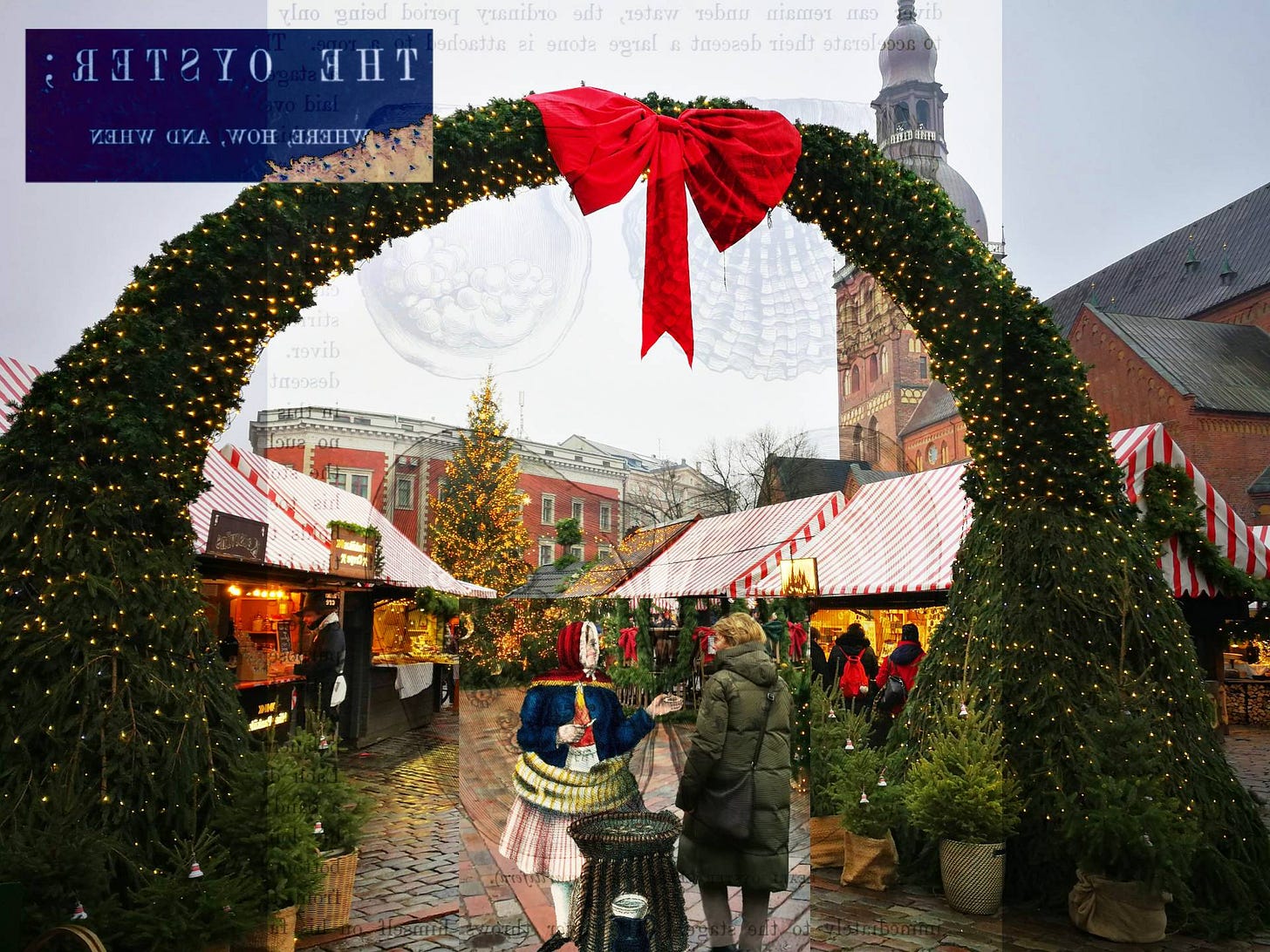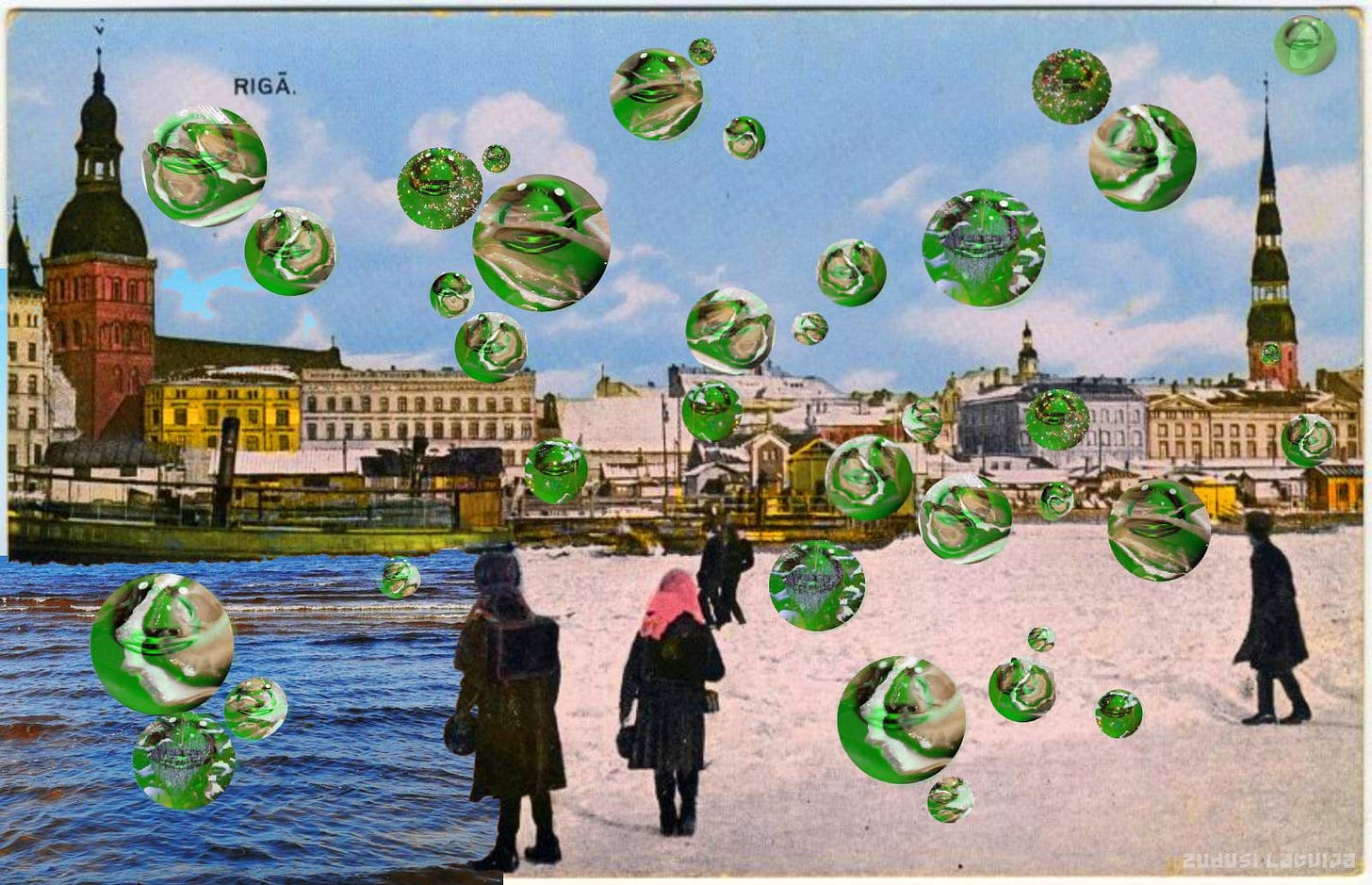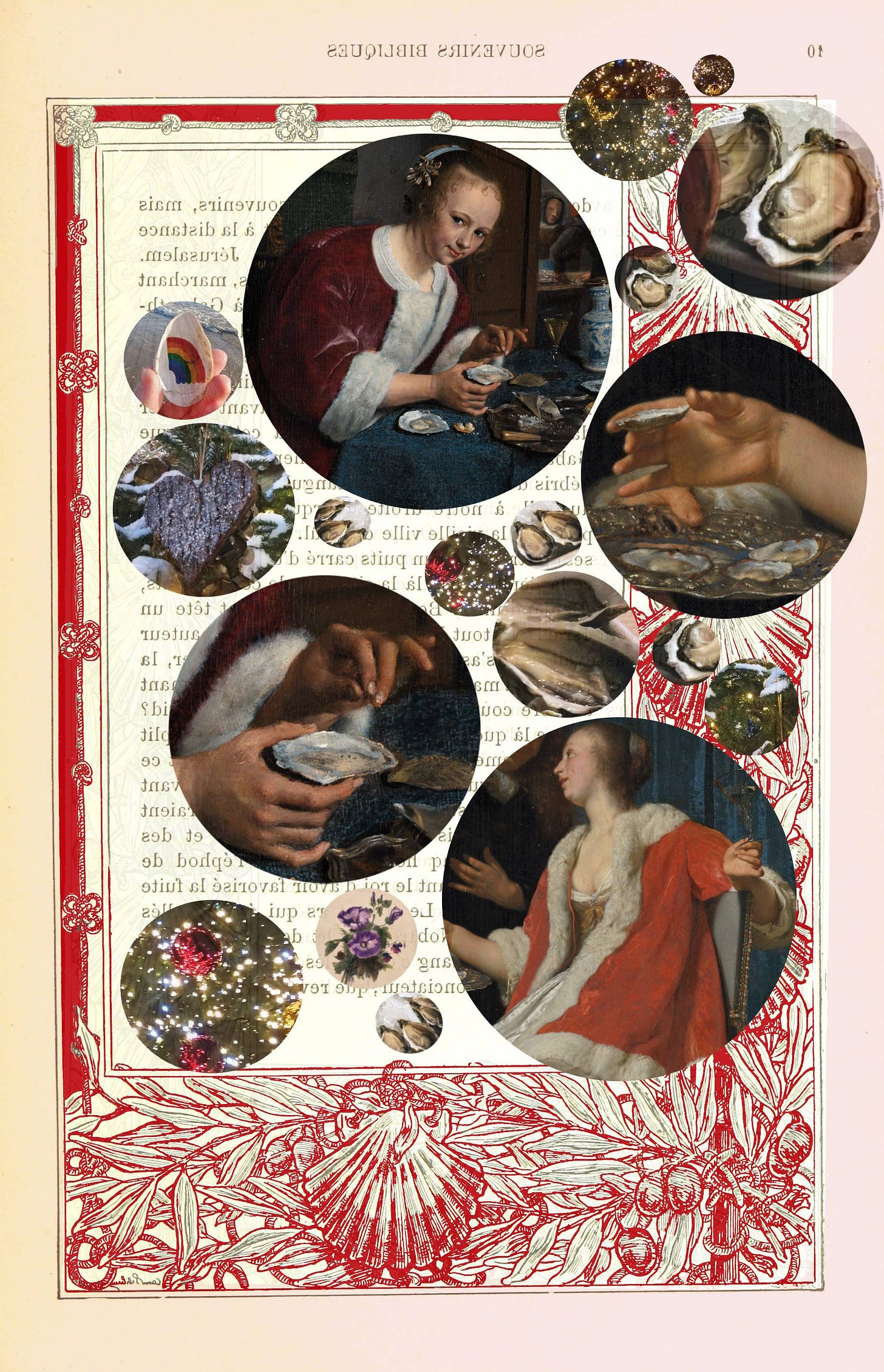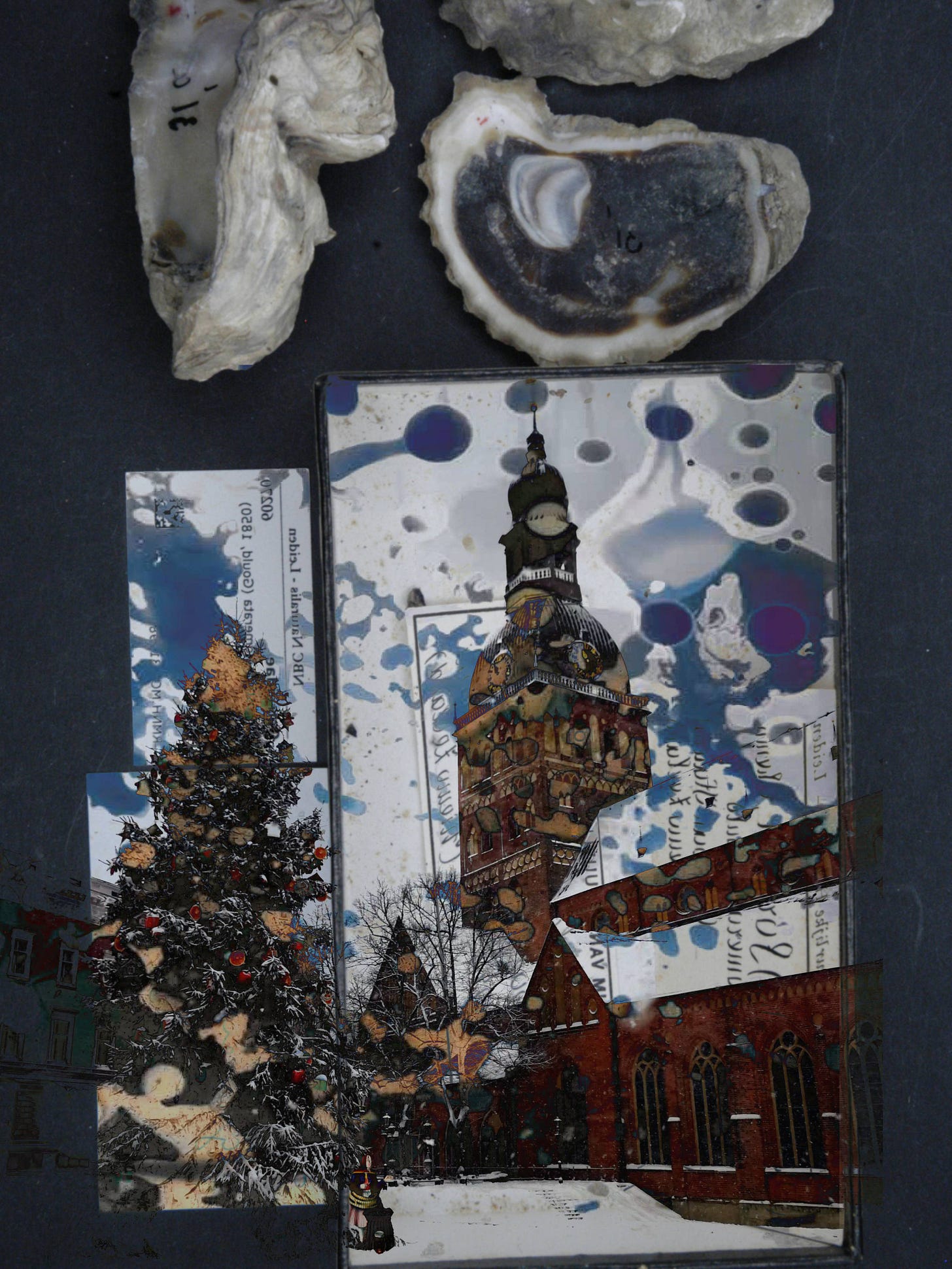Oysters; where, how and when
a very long essay about my digital residency, collages, grief - and oysters
Riga, Christmas Eve 2024. My partner and I went to the Christmas exhibition at the Art Nouveau museum and then we went to our favourite Christmas market downtown. On Instagram, I saw that this year’s market had all the traditional Latvian food–grey peas, sausages, braised cabbage–and some usual street food like hot dogs and pancakes. Also, there was a new stall with grilled oysters, and I was curious to try them.
We enjoy Christmas markets every year. The brightness, music, aromas, and happy crowds–all of it helps with my seasonal depression and brings on the holiday feeling. Every year we visit markets several times to drink something, eat something, and enjoy each other’s company and the company of our friends. We have favourite vendors and go-to spots.
That winter I was keen to try oysters in Christmassy surroundings. Oysters don’t seem like a wintery, outside food, and I felt that the contrast might be impressive.
Oh, it was!
Oysters were delicious and festive! The contrast definitely worked, and for a while it was an absolute winter fairytale–Christmas decorations, hot seafood. I am rarely impressed with food as much as I was then–and I immediately knew I wanted to return, and do that again.
*
February, 2025. I listened to Europeana’s online lecture about a creative residency during a misty beach walk in Ventspils. Europeana is a digital platform for European cultural heritage–they host images, texts, artworks, archival materials from museums, libraries, and more.
I liked their projects, and I wanted to apply for the residency, but the second I heard the theme I was less inclined. The theme was “food” and that’s not an easy subject for a person with an eating disorder.
Well, it wasn’t for me then, ok. But I still wanted to apply because I was craving to have some visual art projects, and I wanted to work with collages in a new way.
So I thought, what about the food might be interesting to explore?
What might not lead to the sense of guilt, self-loathing, and self-harm?
I thought about my times at the Christmas market and oysters, and how it was less about the food and more about experience. I thought about how I didn’t want to write about them but I wanted to create some art based on my memories.
*
Usually, my collages are more about art therapy (it’s soothing to sit on the floor, go through art and fashion magazines, and cut things out) and me working with limitations (I only have what I have, I cannot change size or colours of my objects).
I rarely create collages that stand alone as artworks. I wanted to change that.
*
I applied with my oyster project–several collages about a dreamy, ethereal, festive experience. I was excited about that project. I told myself that even if I don’t get a spot no one is forbidding me to do the collages myself.
Truth to be told, I knew that I probably wouldn't. It’s been a huge issue for several years–my inability to finish my art work even if I am extremely enthusiastic about it.
So I prepared to leave my oyster project in the huge, messy idea list with little hope to actually return to it.
*
2024 was the first year since the pandemic when I felt like I was returning to myself. I felt less depressed. I could feel emotions again–pleasant, not so pleasant, all of them.
It was incredible.
It was also very intense.
*
In April 2025 I got an email starting this way:
Dear Katerina,
Thank you for your application to the Digital Storytelling Festival Online Creative Residency.
We were delighted to receive a lot of really good applications from a lot of great people. We have considered each application carefully, assessing what each applicant wanted to achieve with the residency, what experience and interests they have and how they think they will benefit from the residency.
This kind of beginning, I was sure, will continue with–sorry, love, better luck next time–but then I read:
As a result, we are delighted to let you know that we would like you to take part in the residency in the Collage art strand.
I was also delighted! My first non-writing residency, my first online one! And collages, as I wanted!
I happily told my partner and we decided that we should celebrate with oysters, in a proper oyster place this time.
*
The last months of 2024 I spent waiting for and dreading my month-long residency in International Writers' and Translators' House in Ventspils. The waiting list there is enormous, I was waiting for two years and at some point I stopped believing that it would ever happen.
But then I got a letter from the residency’s administrator with details, and it became real. I was excited. I was anxious. I was scared that something would happen and I wouldn’t be able to go.
*
In May, 2025, after the first Europeana residency call I had some useful thoughts from my mentor, Cosmina Berta:
_ not to search for objects to use in a collage but browse for them,
_ collages are great for re-contextualising things,
_ and for merging the past and the present.
*
It’s what I’m doing writing this.
Well, this is why this form is called a collage essay, and it delights me to use it, exploring my collage residency experience.
*
My browsing results on Europeana were unexpected.
I looked for Christmas markets, wintery Riga, and oysters. I expected to find plenty of markets, oysters—not so much. Reality was the opposite. I found plenty of oysters: drawings from old manuscripts, paintings, photos, museum’s cards, book pages—lots and lots of options.
I found some nice photographs and postcards of Riga.
Christmas markets and Christmas trees were nowhere to be found. It was confusing.
*
My first attempts with digital collages were very freeing. I could do all I wanted, change everything and anything. It was fun: exploring new media (digital pictures) and a new service (I used free Photopea). It was all fun and overwhelming. I loved it.
As a result I got the ugliest things I have ever created.
These are important, it is important to create a space for learning, making “ugly” art, and looking at it with joy. Yes, I made that, and now I know how, and I can list all the things I hate and I can stop repeating them and think more about what I enjoy.
*
In June, 2025, on our second residency call we discussed different collages and what makes a collage interesting. We discussed food and its different connotations.
I shared my idea with my mentor–it helped me clarify it. She introduced me to a handy way to describe a collage:
_ name
_ idea
_ story (if there is any)
_ techniques and materials used
_ emotions I want to evoke
Also, she asked if I wanted to accompany my collages with an essay, me being a writer and all. I agreed even though one of the points of making collages was my reluctance to put it all into words.
*
Sometimes you can’t stay silent anymore but it’s impossible to talk about things that make you silent.
Sometimes you chose to tell something else and in this particular case it was my beautiful oysters experience. Bright Christmas market, delicious taste. Lovely!
And, me being a writer and all, I still have this fear of words. If I write about something–it is real.
But without my words…
*
On a rainy day my partner and I went to a restaurant for oysters.
A dozen on ice, beer, a rude waitress and our unwillingness to let her attitude ruin our night.
The first oyster smelled and tasted exactly like the Japanese sea, the sea of my childhood. The oyster lived in France, a different sea, in a different ocean, but the taste, the smell–it was like I was swimming, and waves were covering me, and I breathed water in. There was a moment, there was always a moment when I wondered, will the water take me?
I didn’t expect to experience that during our nice little date. I waited a second to get back to reality.
The oysters were delicious, the conversation was nice, and we had a great time.
When we were ready to leave, I asked a waitress for a box. I wanted to take several shells home to use in an assemblage. She brought me a plastic box–it brought the fanciness of the place down.
*
Looking for Christmas markets and trees on Europeana was getting frustrating and then, there was one more thing.
As a feminist–artist and person–I always want to include female art in my work, do it as much as possible. But the objects I was finding were mostly–if not exclusively–made by men.
So I thought, what if I use my own photos of Riga’s markets? It will make my collages even more personal and it will even out some of the gender imbalance.
I went through my wintry photos and through my findings from Europeana.
Finally, the ideas I had started to gain some visuals.
*
In October 2024 my partner’s mum’s cancer was back.
*
My whole collage quartet grew from the name of the book I found on Europeana.eu The oyster; where, how and when to find, breed, cook and eat it.
The oyster; where, how and when. Yes. I loved that.
*
The first collage, the titular one, is an invitation to share the experience.
It’s a photo of the Christmas market on the Dome square, with a green arch as an entrance. There are two women there, one is selling oysters, the other is buying. One is a cut out from the lithograph, the other is a real one.
This collage welcomes the audience with its warm colours and composition. I think it’s delightful, the interaction of the real woman and the painted one. And it’s dreamlike, the text is mirrored for that effect, and the photo is mirrored too, so, if you know this place, visited it, you will feel that something is not quite right.
But please, come in. Share the joy.

*
Is it even possible to share the grief?
*
Winters in Riga are dark and long, and the last one was one of the worst. It wasn’t cold enough for snow, so we had rain, and more rain, and even more rain.
I was trying to not succumb to depression–not again–and I tried to manage my seasonal one. I put all of my hopes into the Christmas festivities.
It was ironic–my partner and I don’t even celebrate Christmas. But you don’t need to celebrate it to enjoy holiday merrymaking.
And my enjoyment was so remarkable that I was returning to it again and again.
*
I’ve shown enough excitement that I almost became an oyster person.
A friend brought me a candle in an oyster shell. My partner–a keychain with a stylised oyster pendant. Another writer recommended a book about oysters.
Everything was lovely. The candle was great and I burnt it while doing art. The pendant is on my keys, I love its size and shape. The book Considering the Oyster by M.F.K. Fisher was great. I loved the text and the personality of the authoress. I read it in two days and was sharing random facts about the oysters for weeks. I really wanted to use the book in my collages, but alas, copyright’s restrictions.
*
The second collage, the surreal one.
where? in Riga.
Beautiful, unrealistic sunny and crisp winter day on an old postcard. People are walking on the ice and snow-bound Daugava river. They are going toward Old Town, where the Christmas market is located. Surrounding them are bright green bubbles. Inside the bubbles are oysters (photos from our celebratory dinner with my partner), and Christmas lights (photos of Riga’s Christmas trees), and one photo of my keychain pendant (if you can spot it).
It’s delightful. It’s absurd. It’s dreamlike. Do these people usually have these bubbles around them? Is it normal weather for them? Or are these their dreams? Because they, too, need to have something joyful in their life?
And are they, too, mere moments away from drowning?

*
I spent several weeks furiously and unsuccessfully trying to get rid of the shells’ smell.
I tried vinegar, salt, bleach, baking soda, boiling them, and–my last resort–calmly explaining to them that I can not continue in that way, and, wow, how I hate every TV show I ever saw where someone disposed of the whole human body without the smell alerting everyone.
Something–or a combination of everything, including my speech–helped. The shells lost their smell–and their pigment. They became white, and I didn’t want white.
*
Early December 2024 I did my usual blood tests, and it wasn’t good.
Early December I was at the doctor’s office, and she was explaining my new diagnosis to me. Also she was repeating how the best solution for my chronic issue would be an operation after which I will have to take meds for the rest of my life. I was trying to explain to her that I refuse to willingly put myself in this position. I don’t feel that we live in a stable enough world for that.
But what can happen? She asked, irritated.
Anything. I answered, even more irritated. War can begin. We might need to leave the country.
*
I really didn’t expect to enjoy digital collaging this much.
Digging through archives on Europeana, wandering through all of the different pictures, then finding myself with new stories to create.
*
The third collage, the cute one.
how? together.
I found the woman on the top early on during my browsing of Europeana. The painting was called Girl Eating Oysters. I liked this woman being flirty, mischievous, maybe even promiscuous. And I immediately thought–I like all of that for you but I don’t like that your look is directed towards the male painter and male audience. Then I found a painting from the same time period (the middle of XVII century) that was called The Oyster Meal. There was a man who was seducing a woman with oysters. The woman looked exasperated.
Collages are great for re-imagining stories and the one I chose to tell here is about a happy lesbian couple enjoying oysters together. The one on the top is seconds away from making a very stupid, vulgar joke, and the one on the bottom is rolling her eyes because omg babe can you not. It's a playful, intimate moment between them.
Both are very happy with each other.
But. The thing with queer art is that even if you don’t do it subtly there will be people who will misunderstand the relationship between the characters.
I thought it read queer. But you know what, let's be even more clear. I added a bouquet of pansies by Elisa-Honorine Champin (that’s a very local thing–Riga Pride has its own flower language, and pansies mean queers. And I like the fact that they were drawn by a woman). Is it enough? I added a heart–one of the Christmas ornaments from Riga’s Christmas tree. Then I thought some more and slapped a shell with a rainbow on it (from another of my artworks).
I think the only way I could’ve been more clear is if I just wrote “these are lesbians” (I did consider it for a second). Even then, I’m sure the “these are such nice friends” crowd would find a way to miss it.
Again, the bubbles for some whimsy, again the letters are mirrored for dreamlike effect.
This one is about the pure joy of being together.
*
That’s the fragile one.
There is a very irritating and harmful trope in art, the one about queer couples never getting a happy ending.
There are plenty of others but this one’s making me furious. Its message is very clear–even if it’s good for now, you will never get your happily ever after.
As a person I don’t even believe in happily ever after. But as a writer and an artist I find it extremely important to once in a while create the sweetest, the most blissful queer couples that are not harmed by homophobia or queerphobia, or anything, actually.
They might be a story in a story, framed twice, like in my collage. But there is no conflict, no drama, nothing unpleasant.
It’s vital to create such happiness, like this couple in their bubbles.
It’s vital to see such happiness.

*
I didn’t like white shells.
I didn’t even plan to make an assemblage with them at that point, not anymore, but I couldn’t stop.
How does one restore the pigment of the oyster shells? With oil, the internet said. I used coconut butter. I liquified it between my palms. Then, one by one I massaged the shells with butter, and looked at how the colours returned to them–grey, pink, purple, white–the other kind of white, not the baking soda one.
I called my partner to look, he came in and was dutifully impressed. I am very grateful he doesn’t mind my art stuff all around our apartment. I put my newly beautiful, though buttery shells all over the bathroom. The internet said they would absorb the butter in some time.
*
Somewhere in November 2024 I started to constantly feel the sharp pain in my chest–muscle tightness that sometimes felt like it was my heart. It wasn’t.
But it felt just like that. And the more I googled symptoms, the more of them I displayed. It was painful to move my left arm. I felt burning in it. And the chest pain.
I did yoga through it. I meditated. I did breathing exercises. I was journaling.
The pain was getting worse and worse.
*
The problem with online residencies is that you stay at home. A lot of things were happening with me: my first exhibition, other art projects, art festival, Pride, volunteering, holiday trip.
I would’ve loved to be more present but I wasn’t.
*
What to do with the shells? I’ve put so much time and effort into them.
One I wanted to use in a sculpture. One I wanted to break with a hammer but I didn’t know where to do it. I didn’t feel like doing it inside of the apartment. I thought about stepping on one to see what will happen with it and with my skin.
Then, I saw an ad for a chemigram workshop with artist Agate Tūna. Chemigrams, as the artist says, are photography without a camera. An experimental type of art where the images are made by painting with chemicals on light-sensitive paper.
I brought a couple of shells for the workshop, hoping to use them. I couldn’t, not really, you need flat things for this art.
*
I enjoyed working with Cosmina, my mentor. It was my first time interacting with someone whose main art practice is collages, and I’m happy that I got that experience. It was interesting and useful to listen to my mentor, to discuss ideas with her. It helped me get some clarity, understand my visual language and preferences better, and move from art therapy to art–as I wanted.
I enjoyed the sense of achievement when I finished my quartet of collages.
I enjoyed the desire to write this essay.
*
The last collage, the eerie one.
when? winter night
*
Ludmila, my partner’s mum, died on the night of December 29th, 2024.
*
For my last collage I used a photo of pandemic Christmas. No markets, no people. Empty Dome square. Christmas tree. The photo is mirrored.
On top of it is one of my pictures from the chemigram workshop. Bubbles are bleeding blue.
On top of that is a museum card with a description of oysters and species’ shells on the side. It’s mirrored.

*
My residency mentor asked if there is any transformation in my quartet. I answered that it’s not about transformation, it’s a movement through experience. It is a joyful and exciting thing we created but it’s not for escaping reality. It is all still there, and we need to pay attention.
*
The second part of my oyster experience went like that.
It was January the first, 2025. My partner and I just finished gathering his mother’s clothes for the funeral home. The funeral was planned in a couple of days.
My partner cried a lot. I didn’t but there wasn’t a breath I was taking that did not bring more sharp pain.
I was doing my best to help. I was trying to be there for him.
Everything was acute, raw. Colours were bright, sounds were loud. I could barely handle the feeling of fabric on my skin.
After we finished at his mother’s apartment, we went to the Christmas market. It was raining.
The stall with oysters was open. We chose five, with different sauces. A seller grilled the oysters, grilled the toasts. We bought blackcurrant drinks.
Then, we stood in front of the shining Christmas tree and we ate. The broth was delicious, we put our toasts in it, it was way better than to eat it with the spoon–and cleaner, too. Last time I ended up with several spots on my scarf.
It was dark. Winter days are so short. It was still raining.
Not many people were around us.
We were talking about food, how lovely it was. We were smiling at each other.
We were creating something, choosing not to be washed away by grief.
*
In my last collage, almost invisible, there is a girl selling oysters from the first one. She is alone.
But she is there.
Many thanks to Cosmina Berta, Beth Daley and the whole Europeana team.
